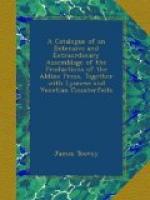Delayed, all friends shut out, the housemates sit
Around the radiant fire-place, enclosed
In a tumultuous privacy of storm.
Come see the north wind’s masonry.
Out of an unseen quarry evermore
Furnished with tile, the fierce artificer
Curves his white bastions with projected roof
Round every windward stake, or tree, or door.
Speeding, the myriad-handed, his wild work
So fanciful, so savage, nought cares he
For number or proportion. Mockingly
On coop or kennel he hangs Parian wreaths;
A swan-like form invests the hidden thorn:
Fills up the farmer’s lane from wall to wall,
Maugre the farmer’s sighs, and at the gate
A tapering turret overtops the work.
And when his hours are numbered, and the world
Is all his own, retiring, as he were not,
Leaves, when the sun appears, astonished Art
To mimic in slow structures, stone by stone,
Built in an age, the mad wind’s night-work,
The frolic architecture of the snow.”
In Mr. Bryant’s “Winter Piece” we have a brilliant description of frost-work:
“Look!
the massy trunks
Are cased in the pure crystal; each light
spray
Nodding and tinkling in the breath of
heaven,
Is studded with its trembling water-drops,
That glimmer with an amethystine light.
But round the parent stem the long low
boughs
Bend, in a glittering ring, and arbors
hide
The glassy floor. Oh! you might deem
the spot
The spacious cavern of some virgin mine,
Deep in the womb of earth—where
the gems grow,
And diamonds put forth radiant rods and
bud
With amethyst and topaz—and
the place
Lit up, most royally, with the pure beam
That dwells in them. Or haply the
vast hall
Of fairy palace, that outlasts the night,
And fades not in the glory of the sun;—
Where crystal columns send forth slender
shafts
And crossing arches; and fantastic aisles
Wind from the sight in brightness, and
are lost,
Among the crowded pillars. Raise
thine eye;
Thou seest no cavern roof, no palace vault;
There the blue sky and the white drifting
cloud
Look in. Again the wildered fancy
dreams
Of spouting fountains, frozen as they
rose,
And fixed, with all their branching jets,
in air,
And all their sluices sealed. All,
all is light;
Light without shade. But all shall
pass away
With the next sun. From numberless
vast trunks,
Loosened, the crashing ice shall make
a sound
Like the far roar of rivers, and the eve
Shall close o’er the brown woods
as it was wont.”
Winter, itself, has never been more happily impersonated than by dear old Spenser. We meant to close with his portrait of Winter, but, on second thoughts, we give, as more seasonable, his description of January. The fourth line can hardly fail to remind the reader of the second line of Shakspeare’s song, and to suggest the query—whether Shakspeare borrowed from Spenser, Spenser from Shakspeare, or both from Nature?




